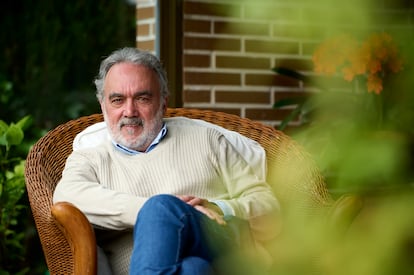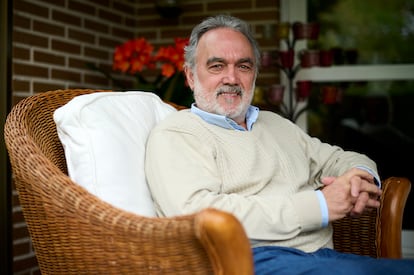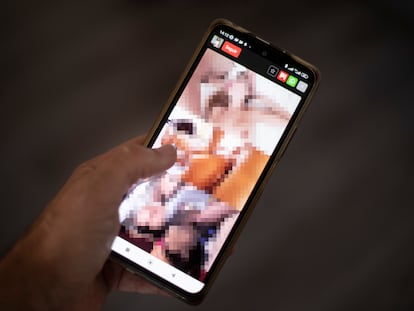‘Kids are always going to come across porn. We need to educate them so they know how to understand what they find’
The clinical psychologist and sex educator José Luis García has spent four decades studying the effects of pornography on minors

José Luis García has spent more than four decades immersed in porn: in how porn comes part of the lives of adolescents and adults; how it paralyzes and changes them; in how it affects their sex lives and sexual violence, more and more frequent among young people. He has studied it both as a clinical psychologist and in the Navarra public health system, where he has worked for 36 years, five of them as the community’s director of the Center for Family Planning and Sex Education. He has also taken on the topic in auditoriums, classrooms, high schools and universities. Now he is the co-director of the first course of Prevention of the Effects of Pornography on Sexual Health, at the King Juan Carlos University in Madrid. Over the phone from Navarra, where he lives, he talks about what he has seen in recent decades, an “abysmal shift” in how we grow, interact and socialize with porn. He also discusses the “naïve” idea of “getting rid of” porn. For García, one thing is certain: “We have to talk about porn [with minors], because it will not disappear. It only will when it stops being consumed.”
Question. What about regulating it?
Answer. The internet would have to be regulated so that violent porn could not exist. It is a very complicated task, and I don’t know whether it would be possible. I would say it’s impossible. There are millions of websites in different countries. You can go after one and the next day ten more appear. They are very powerful companies.
Q. You know the day-to-day of minors in this sense: how they see it, from what devices, what relationship they have with pornography. You don’t think there’s a way to moderate it?
A. Any child with a cell phone will come across porn. Something must be done from a legal standpoint, advocating for the creation of infinite obstacles for minors, looking for ways to control access. It shouldn’t be the case that any minor can, without any control, access millions of films that show extreme violence, with the negative impact that that has on sexual education.
Q. But you don’t believe in banning it, or trying to.
A. No, because I don’t believe it’s possible in the short or medium term. History shows us that the prohibition of drugs, for example, increases the consumption of what you want to ban. Porn is a very powerful drug, as it stimulates sexual desire, and it is free.

Q. And what do you believe in?
A. Sexual education. Teaching kids early so that they can learn to make decisions. Talking about what porn is, showing them what it reflects, explaining why it isn’t emotionally healthy, and explaining to them that if they have sexual interests, there are other, non-violent alternatives. Human beings have always sought sexual stimuli, and we know that audiovisual media make it reach our brain with more impact, more quickly. The reactions of pleasure and well-being are very quick, especially in an adolescent brain that is developing. That’s why, if they’re going to see porn, we have to educate them so that they, and those who they interact with, are as healthy as possible. I give a lot of courses with teenagers and adults, and when we talk about alcohol or tobacco, we say the same thing: they’re going to find it, and we have to educate them so that they decide, so that they know how to manage the realities they’re going to find.
Q. Do you think families, teachers, educators are willing to do that?
A. I have spent 45 years doing this in an intense, passionate way, and it has brought me a lot of difficulties, but more and more recently. We are moving backwards, and there are fewer professionals interested in this topic. Thirty years ago, the environment was very positive, and now I don’t see that attitude.
Q. What do you see?
A. There are a ton of difficulties in education. Family environments don’t favor it either. Who does it? There are many teachers who don’t want to get into that, either because parents complain, or because they aren’t trained, or because they aren’t paid for it. There are many parents who don’t want it discussed at school, and they believe it is something private to talk about at home. It’s not, because no one wants to get into it. I’m a little pessimistic.
Q. Despite the advances we’ve made?
A. Laws about sexual freedom and abortion are advances, but they need to be put into action, developed and funded, because if we don’t train teachers, broadly, systemically, and scientifically, we won’t do anything. If we want it to be efficient, so that adolescents can decide what kind of porn they watch, or whether or not they watch it, isn’t a topic to deal with in one day or one talk. There’s the example of the condom. The fact that a teenager knows what it is and how it’s used doesn’t mean that they will buy it or carry it with them or use it systematically. Its use requires preparation, knowledge, information, conscientiousness about responsible sex.
Q. There aren’t many condoms in porn.
A. No. They’re invisible. There are still plenty of undesired pregnancies and a rapid increase, in the last decade, in sexually transmitted diseases and sexual violence.
Q. Do you think those phenomena are related?
A. There is enough scientific evidence to suggest that they are. Porn is the model that young people follow. It is the only instructions manual they have, so it makes sense that it would be related. We have a generation of pornographic children, who have learned about sex and relationships through violent porn, being how a man mistreats a woman, aroused and feeling pleasure. It is a model that teaches values and attitudes. There are studies that say that 25% of people, by 20 years old, will have watched between 1,000 and 5,000 hours of porn. If a 20-second advertisement can affect our behavior, of course that enormous amount of dopamine that porn generates will have an effect.

Q. What consequences have you seen over the course of your career?
A. Very sexually active kids, precocious in their relationships, different alcohol and drug consumption disorders, brain alterations, mental health problems, problems with their partners because he wants to do things that she doesn’t want to do. That can lead to resorting to prostitution, the sexual exploitation of poor and vulnerable women. There are also terrible cases of girls who have participated in sexual practices that they don’t desire, like anal penetration or choking, who don’t know how to do it but they do it because their boyfriends ask and they’re in love, or because they saw it and “the porn girl did it so easily and she enjoyed it so much,” or because their friends have told them about it. Anal lesions, pain, emotional changes…
Q. And sexual violence?
A. And sexual violence. This idea of sexuality based on porn is poor and fragile. Porn is veery perverse, because in porn sex is tolerable, acceptable sexual violence. It gives the idea that it’s very easy to pick someone up or to fuck. In porn, no man ever goes without penetrating the woman. The message is that having sex is easy, that women like to be forced and hit and, in the extreme, to be raped. That violence or submitting them is exciting. That sex always implies intercourse, without protection, humiliating women. Porn alters humans’ capacity for empathy and compassion.
Q. What would be an optimal model?
A. Sex positivity, with well-being, passion, pleasure, empathy and mutual agreement. A healthy sexuality that teaches them that sex can be one of the most marvelous things in a person’s life, and that those who use violence are, in reality, losing out on that experience.
Q. Is it urgent to impose that model?
A. Very much so. It is a serious issue, with sufficient evidence to make decisions as soon as possible. If we don’t do it, we’re leaving the sexual futures of our teenagers to pornography, and we’re going to have generations with a lot of problems. We have to choose: violent porn, or mothers, fathers and teachers.
Sign up for our weekly newsletter to get more English-language news coverage from EL PAÍS USA Edition
Tu suscripción se está usando en otro dispositivo
¿Quieres añadir otro usuario a tu suscripción?
Si continúas leyendo en este dispositivo, no se podrá leer en el otro.
FlechaTu suscripción se está usando en otro dispositivo y solo puedes acceder a EL PAÍS desde un dispositivo a la vez.
Si quieres compartir tu cuenta, cambia tu suscripción a la modalidad Premium, así podrás añadir otro usuario. Cada uno accederá con su propia cuenta de email, lo que os permitirá personalizar vuestra experiencia en EL PAÍS.
¿Tienes una suscripción de empresa? Accede aquí para contratar más cuentas.
En el caso de no saber quién está usando tu cuenta, te recomendamos cambiar tu contraseña aquí.
Si decides continuar compartiendo tu cuenta, este mensaje se mostrará en tu dispositivo y en el de la otra persona que está usando tu cuenta de forma indefinida, afectando a tu experiencia de lectura. Puedes consultar aquí los términos y condiciones de la suscripción digital.
More information
Archived In
Últimas noticias
Most viewed
- David King, chemist: ‘There are scientists studying how to cool the planet; nobody should stop these experiments from happening’
- Reinhard Genzel, Nobel laureate in physics: ‘One-minute videos will never give you the truth’
- Mexico completes its trade shift with the entry into force of tariffs on China and countries without trade agreements
- Oona Chaplin: ‘I told James Cameron that I was living in a treehouse and starting a permaculture project with a friend’
- Sinaloa Cartel war is taking its toll on Los Chapitos











































